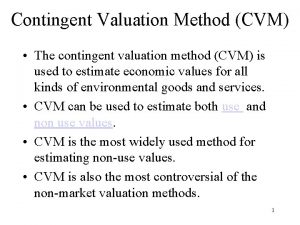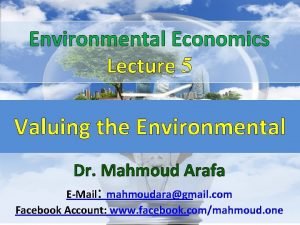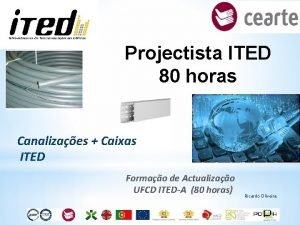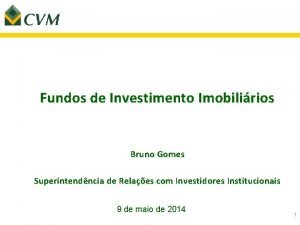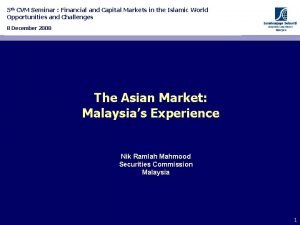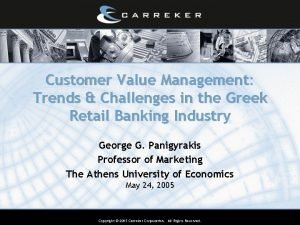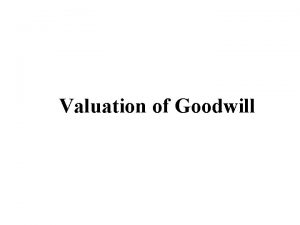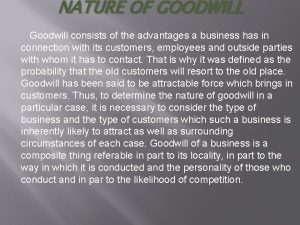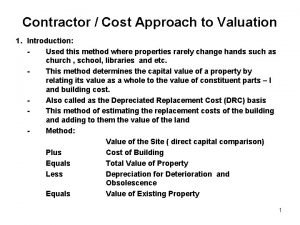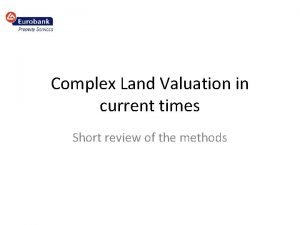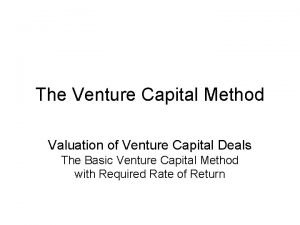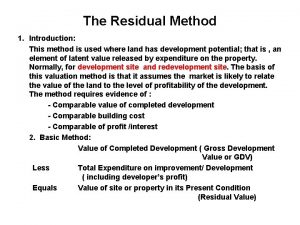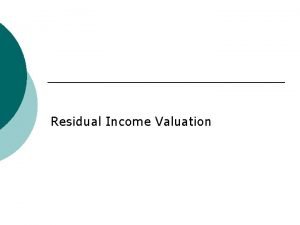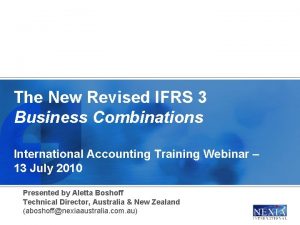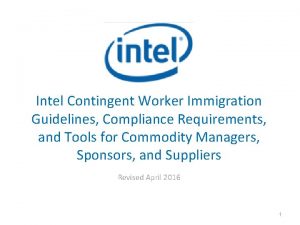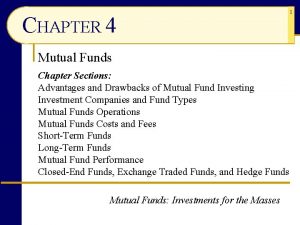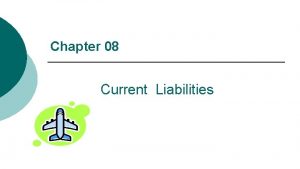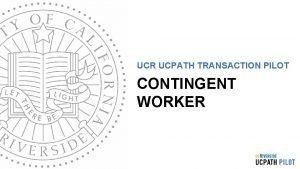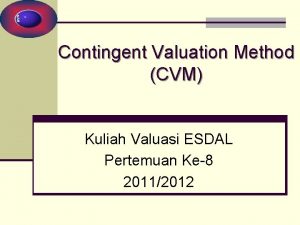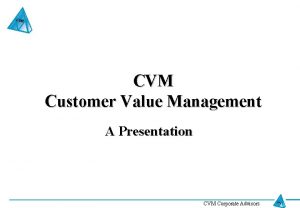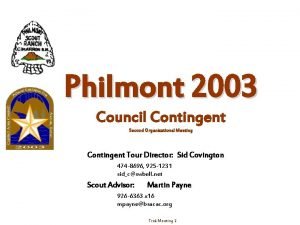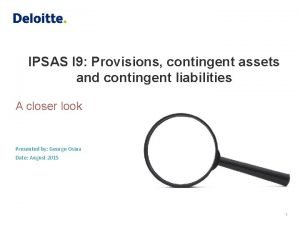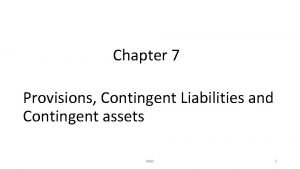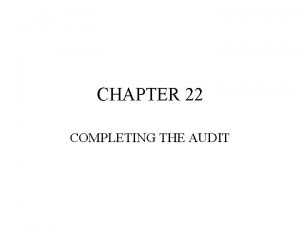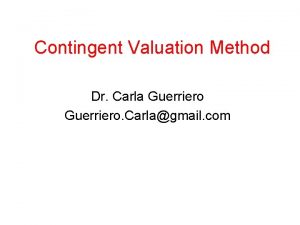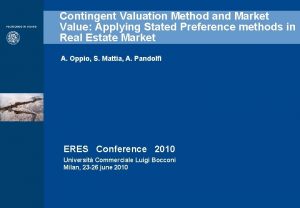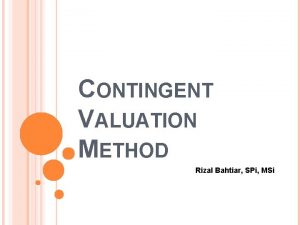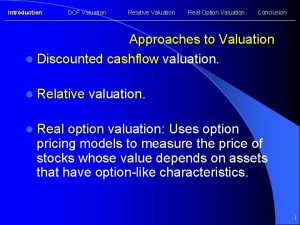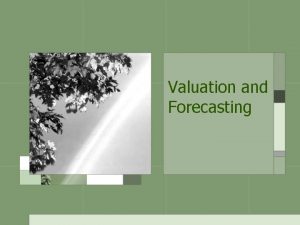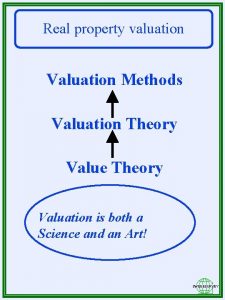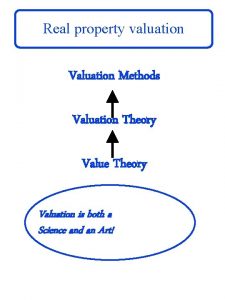Contingent Valuation Method CVM The contingent valuation method






































































- Slides: 70

Contingent Valuation Method (CVM) • The contingent valuation method (CVM) is used to estimate economic values for all kinds of environmental goods and services. • CVM can be used to estimate both use and non use values. • CVM is the most widely used method for estimating non-use values. • CVM is also the most controversial of the non-market valuation methods. 1

CVM- Overview • CVM involves directly asking people, in a survey, how much they would be WTP for specific environmental goods or services. • In some cases, people are asked for the amount of compensation they would be WTA to give up specific environmental goods or services. • It is called “contingent” valuation, because people are asked to state their WTP or WTA, contingent on a specific hypothetical scenario and description of the 2 environmental good or service.

CVM-Overview • CVM is referred to as a “stated preference” method, because it asks people to directly state their values, rather than inferring values from actual choices, as the “revealed preference” methods do. • CVM circumvents the absence of markets for environmental goods and service by presenting consumers with hypothetical markets in which they have the opportunity to pay or accept compensation for the environmental good or service in question. • The hypothetical market may be modelled after either a private goods market or a political market. 3

CVM-Overview • The fact that CV is based on what people say they would do, as opposed to what people are observed to do, is the source of its greatest strengths and its greatest weaknesses. • Contingent valuation is one of the very few ways to assign monetary values to non-use values of the environment—values that do not involve market purchases and may not involve direct participation. • These values are sometimes referred to as 4 “passive use” values.

CVM-Overview • They include everything from the basic life support functions associated with ecosystem health or biodiversity, to the enjoyment of a scenic vista or a wilderness experience, to appreciating the option to fish or bird watch in the future, or the right to bequest those options to your grandchildren. It also includes the value people place on simply knowing that giant pandas or whales exist. 5

CVM-Overview • It is clear that people are WTP for non-use, or passive use, environmental benefits. • However, these benefits are likely to be implicitly treated as zero unless their monetary value is somehow estimated. • So, how much are they worth? • Since people do not reveal their willingness to pay for them through their purchases or by their behaviour, the only option for estimating a value is by asking them questions. 6

CVM-Overview • However, the fact that the CVM is based on asking people questions, as opposed to observing their actual behaviour, is the source of enormous controversy. • The conceptual, empirical, and practical problems associated with developing monetary estimates of economic value on the basis of how people respond to hypothetical questions about hypothetical market situations are debated constantly in the economics literature. 7

CVM-Overview • CV researchers are attempting to address these problems, but they are far from finished. • Meanwhile, many economists, as well as many psychologists and sociologists, for many different reasons, do not believe the monetary estimates that result from CV are valid. • More importantly, many jurists and policymakers will not accept the results of CV. • However, monetary values derived from CVM are accepted as evidence in Court (since the Exxon oil spill case, 1989) 8

CVM- Design: Step 1 • The first step is to define the valuation problem. • This would include determining exactly what environmental goods or services are being valued. • This would also include determining who the relevant population is (local residents, general public, visitors to the area). 9

CVM- Design: Step 2 • The second step is to make preliminary decisions about the survey itself. • These include whether it will be conducted by mail, phone or in person, how large the sample size will be, who will be surveyed, and other related questions. • The answers will depend, among other things, on the importance of the valuation issue, the complexity of the question being asked, and the size of the budget. 10

CVM- Design: Step 2 • In-person interviews are generally the most effective for complex questions, because it is often easier to explain the required background information to respondents in person, and people are more likely to complete a long survey when they are interviewed in person. • In some cases, visual aids such as videos or colour photographs may be presented to help respondents understand the conditions of the scenario that they are being asked to 11 value.

CVM- Design: Step 2 • In-person interviews are generally the most expensive type of survey. • Mail surveys that follow procedures that aim to obtain high response rates can also be quite expensive. • Mail and telephone surveys must be kept fairly short, or response rates are likely to drop dramatically. • Telephone surveys may be less expensive, but it is often difficult to ask CV questions over the telephone, because of the amount 12 of background information required.

CVM- Design: Step 3 • The third step is the actual survey design, which is accomplished in several steps. • The survey design process usually starts with initial interviews and/or focus groups with the types of people who will be receiving the final survey. 13

CVM- Design: Step 3 • In the initial focus groups, the researchers would ask general questions, including questions about peoples’ understanding of the issues related to the environmental good or service, whether they are familiar with it and the issues (e. g. threats, importance) related to it, whether and how they value this environmental good or service. 14

CVM- Design: Step 3 • In later focus groups, the questions would get more detailed and specific, to help develop specific questions for the survey, as well as decide what kind of background information is needed and how to present it. • For example, people might need information on the location and characteristics of the site, the uniqueness the environmental good or service, and whethere any substitutes. 15

CVM- Design: Step 3 • Researchers would also want to learn about peoples’ knowledge of the human induced or other threats to the environmental good or service and their attitudes towards those threats. • Different approaches to the valuation question and different payment mechanisms and vehicles would be tested. – Payment vehicles could be voluntary donations, increase in taxes, increase in entrance fees. – Payment mechanisms include: open ended, payment ladder, single-bounded dichotomous choice, double-bounded dichotomous choice 16

CVM- Design: Step 3 • Questions that can identify any “protest” bids or other answers that do not reveal peoples’ values for the good or service of interest would also be developed and tested at this stage. • Questions about the social and economic characteristics of the respondents (e. g. age, gender, education, income) to understand what segment of the society value the environmental good or service the most/least. 17

CVM- Design: Step 4 • The fourth step is the actual survey implementation. • The first task is to select the survey sample. Ideally, the sample should be a randomly selected sample of the relevant population, using standard statistical sampling methods. • In mail surveys standard repeat-mailing and reminder method should be used to get the greatest possible response rate for the survey. 18

CVM- Design: Step 4 • Telephone surveys are carried out in a similar way, with a certain number of calls to try to reach the selected respondents. • In-person surveys may be conducted with random samples of respondents, or may use “convenience” samples – asking people in public places to fill out the survey. 19

CVM- Design: Step 5 • The fifth and final step is to compile, analyse and report the results. • The data must be entered analysed using statistical techniques appropriate for the type of payment mechanism. • In the data analysis, the researchers also attempt to identify any responses that may not express the respondent’s value for the environmental good or service. 20

CVM- Design: Step 5 • In addition, they can deal with possible nonresponse bias in a number of ways. The most conservative way is to assume that those who did not respond have zero value. • The impact of social and economic characteristics on the respondents’ WTP can also be investigated. 21

CVM- Application • Applying the contingent valuation method is generally a complicated, lengthy, and expensive process. • In order to collect useful data and provide meaningful results, the contingent valuation survey must be properly designed, pre-tested, and implemented. 22

CVM-Application • CV survey questions must focus on specific environmental good(s) and/or service(s) and a specific context that is clearly defined and understood by survey respondents. • A CV survey to assess the monetary value of the results of an environmental improvement cannot be based on the environmental improvement itself, but on increases in specific environmental services that the improvement is expected to provide. 23

CVM- Application • The results of CV surveys are often highly sensitive to what people believe they are being asked to value, as well as the context that is described in the survey. • Thus, it is essential for CV researchers to clearly define the services and the context, and to demonstrate that respondents are actually stating their values for these services when they answer the valuation questions. 24

CVM-Application A good CV study will consider the following in its application: 1. Before designing the survey, learn as much as possible about how people think about the good or service in question. Consider people’s familiarity with the good or service, as well as the importance of such factors as quality, quantity, accessibility, the availability of substitutes, and the reversibility of the change. 25

CVM-Application 2. Determine the extent of the affected populations or markets for the good or service in question, and choose the survey sample based on the appropriate population. 3. The choice scenario must provide an accurate and clear description of the change in environmental goods or services associated with the event, program, investment, or policy choice under consideration. 4. Convey this information using photographs, videos, or other multi-media techniques, and 26 written and verbal descriptions.

CVM-Application 5. Unlike ordinary survey questions, which sometimes ask respondents whether they are willing to pay £x to improve “air quality, ” the nature of the good or service and the changes to be valued must be specified in detail in a CV survey. 6. It is also important to make sure that respondents do not inadvertently assume that one or more related improvements are included. 27

CVM-Application • For example, if people are asked to value only air visibility, it would be important to make sure that they do not include their value for health-related improvements in their stated WTP amount. • Similarly, if people have a tendency to think of environmental improvements in general, even when asked about water quality alone, it would be necessary to point out specifically that environmental quality, other than water quality, would remain the 28 same.

CVM-Application 7. WTP Questions can be asked in a variety of ways, using both open-ended and closedended formats. – In the open-ended format, respondents are asked to state their maximum WTP for the environmental improvement. – With the closed-ended format, also referred to as discrete choice, respondents are asked whether or not they would be WTP a particular amount for the environmental improvement, or whether they would vote yes or no for a specific policy at a given cost. This format is generally accepted as the preferred method. 29

CVM-Application 8. In addition to the hypothetical question that asks for WTP, the survey must specify the mechanism by which the payment will be made, for example through increased taxes or a donation. In order for the question to be effective, the respondent must believe that if the money was paid, whoever was collecting it could effect the specified environmental change. 30

CVM-Application 9. Respondents should be reminded to consider their budget constraints. 10. Specify whether comparable goods or services are available from other sources, when the good is going to be provided, and whether the losses or gains are temporary or permanent. 31

CVM-Application 11. Respondents should understand the frequency of payments required, for example one-off, monthly or annually, and whether or not the payments will be required over a long period of time in order to maintain the quantity or quality change. They should also understand who would have access to the good and who else will pay for it, if it is provided. 32

CVM-Application 12. The scenario should clearly indicate whether the levels being valued are improvements over the status quo, or potential declines in the absence of sufficient payments. 13. If the household is the unit of analysis, the reference income should be the household’s, rather than the respondent’s, income. 33

CVM-Application 14. Thoroughly pre-test the valuation questionnaire for potential biases. Pretesting includes testing different ways of asking the same question and testing whether the question is sensitive to changes in the description of the good or resource being valued. 34

CVM-Application 15. Include validation questions in the survey, to verify comprehension and acceptance of the scenario, and to elicit social and economic and attitudinal characteristics of respondents, in order to better interpret variation in responses across respondents. 16. CVM can be conducted as in-person interviews, telephone interviews or mail surveys. The inperson interview is the most expensive survey administration format, but is generally considered to be the best approach, especially if visual materials are to be presented. 35

CVM-Application 17. Interview a large, clearly defined, representative sample of the affected population. 18. Achieve a high response rate and a mix of respondents that represents the population. 19. The survey results should be analysed and interpreted using statistical methods. 36

CVM-Advantages • CVM can estimate the TEV of environmental goods and services. • A lot of care should be taken while designing CV surveys and analysing data, however it is not a difficult method. • CV has been widely used, and a great deal of research is being conducted to improve the methodology, make results more valid and reliable, and better understand its strengths and limitations. 37

CVM-Advantages • CV is enormously flexible in that it can be used to estimate the economic value of virtually anything. However, it is best able to estimate values for goods and services that are easily identified and understood by respondents. • CV is the most widely accepted method for estimating TEV, including all types of nonuse, or “passive use, ” values. CV can estimate use values, as well as existence values , option values , and bequest values. 38

CVM-Limitations • Although the CVM has been widely used for the past two decades, there is considerable controversy over whether it adequately measures people's WTP/WTA for environmental quality. 39

CVM-Limitations • People have practice making choices with market goods, so their purchasing decisions in markets are likely to reflect their true willingness to pay. CV assumes that people understand the good in question and will reveal their preferences in the contingent market just as they would in a real market. However, most people are unfamiliar with placing monetary values on environmental goods and services. Therefore, they may not have an adequate basis for stating their true value (“hypothetical bias) 40

CVM-Limitations • The expressed answers to a WTP/WTA question in a CV format may be biased because the respondent is actually answering a different question than the surveyor had intended. Rather than expressing value for the good, the respondent might actually be expressing their feelings about the scenario or the valuation exercise itself. 41

CVM-Limitations • For example, respondents may express a positive WTP because they feel good about the act of giving for a social good (referred to as the “warm glow” effect), although they believe that the good itself is unimportant. • Respondents may state a positive WTP in order to signal that they place importance on improved environmental quality in general. 42

CVM-Limitations • Alternatively, some respondents may value the good, but state that they are not WTP for it, because they are protesting some aspect of the scenario, such as increased taxes or the means of providing the good. • Respondents may make associations among environmental goods that the researcher had not intended. For example, if asked for WTP for improved visibility (through reduced pollution), the respondent may actually answer based on the health risks 43 that he or she associates with dirty air.

CVM-Limitations • Some researchers argue that there is a fundamental difference in the way that people make hypothetical decisions relative to the way they make actual decisions. • For example, respondents may fail to take questions seriously because they will not actually be required to pay the stated amount. 44

CVM-Limitations • Responses may be unrealistically high if respondents believe they will not have to pay for the good or service and that their answer may influence the resulting supply of the good. • Conversely, responses may be unrealistically low if respondents believe they will have to pay (freeriding). 45

CVM-Limitations • The payment question can either be phrased as the conventional ‘What are you WTP to receive this environmental asset? ’, or in the less usual form, ‘What are you WTA in compensation for giving up this environmental asset? ’ • In theory, the results should be very close. However, when the two formats have been compared, WTA very significantly exceeds WTP. Critics have claimed that this result invalidates the CVM approach. 46

CVM-Limitations • If people are first asked for their WTP for one part of an environmental asset and then asked to value the whole asset, the amounts stated may be similar. This is referred to as the “embedding effect. ” • In some cases, people’s expressed WTP for something has been found to depend on where it is placed on a list of things being valued. This is referred to as the "ordering problem. " 47

CVM-Limitations • Respondents may give different WTP amounts, depending on the specific payment vehicle chosen. • For example, some payment vehicles, such as taxes, may lead to protest responses from people who do not want increased taxes. • Others, such as a contribution or donation, may lead people to answer in terms of how much they think their “fair share” contribution is, rather than expressing their actual value for the good. 48

CVM-Limitations • Many early studies attempted to prompt respondents by suggesting a starting bid and then increasing or decreasing this bid based upon whether the respondent agreed or refused to pay a such sum. However, it has been shown that the choice of starting bid affects respondents’ final WTP response. • Strategic bias arises when the respondent provides a biased answer in order to influence a particular outcome. 49

CVM-Limitations • Information bias may arise whenever respondents are forced to value attributes with which they have little or no experience. In such cases, the amount and type of information presented to respondents may affect their answers • Non-response bias is a concern when sampling respondents, since individuals who do not respond are likely to have, on average, different values than individuals who do respond. 50

CVM-Limitations • Estimates of non-use values are difficult to validate externally. • When conducted to the exacting standards of the profession, contingent valuation methods can be very expensive and timeconsuming, because of the extensive pretesting and survey work. • Many people, including jurists policymakers, economists, and others, do not believe the results of CV. 51

CVM-Example I • Exxon Valdez oil spill (1989) is caused by the oil tanker running into the rocks releasing 11 million gallons of crude oil • Largest oil spill in US waters resulted in environmental damage of unprecedented proportions 52

CVM-Example I • CVM and non-use (passive use) values entered the dictionary of economics, law and public policy • US court decided that damage claim for environmental losses should also include passive use values • Most of the damages from the spill was passive use since active use of the area was modest • State of Alaska sued Exxon for natural resource damage for lost passive use value 53

CVM-Example I • The only environmental valuation method that can estimate passive use values is CVM • A CV study was carried out to estimate the loss of passive use value from Exxon Valdez spill • Respondents were asked their WTP to prevent a future accident that would cause an equivalent damage in the same area • 1472 respondents randomly sampled from the US population took part in the CV 54 survey

CVM-Example I • CV survey was carefully designed to minimise CV limitations – Use of probability sampling – Referendum elicitation format – In person interviews with cards photos and maps – Accurate description of the valuation scenarios – Checks on understanding and acceptance – Yes/no follow up questions – Careful pre-testing 55

CVM-Example I • Median WTP was found to be $27 -46 and mean $67 -220 • WTP increases with the respondents’ income, likelihood of visit to Alaska, environmentalism, attitude for conservation of wilderness, perception of importance of the accident • Total passive use values amount to $2. 819. 33 billion 56

CVM-Example I • Exxon in fear of the large size of the damage claims being made against it funded a study to discredit CVM • National Oceanic and Atmospheric Administration (NOAA- the government body that is responsible for issuing regulations on the assessment of damage from oil spill) formed a panel consisting of distinguished economists to consider criticisms of CVM and make recommendations to NOAA 57

CVM-Example I • Panel agreed that CVM is valid if the following recommendations are taken into account: – Dichotomous choice format – Minimum response rate of 70% – In person interviewing – WTP rather than WTA – Sensitivity to scope is accounted for – Respondents are reminded of their budget constraints 58

CVM-Example II • Cheimaditida wetland is located 40 km Southeast of Florina in Northwest Greece • This wetland includes Lake Cheimaditida, one of the few remaining freshwater lakes in Greece, and constitutes a total catchment area of 168 km 2 surrounded by extensive marshes with reeds • The wetland is very rich in biodiversity 59

CVM-Example II • It supports six habitat types of Annex I of the EU Habitats Directive (92/43/EEC), one of which is a priority natural habitat under Article 1 • It is very rich in flora diversity (there are 150 relatively rare plant species in the wetland, 6 of which are listed under CITES). • It also supports a wide array of fauna diversity including several mammals, amphibians, reptiles and fish, most of which are listed in Annex II and IV of the EU Habitats Directive (92/43/EEC). • It is a recognised Important Bird Area and approximately 140 bird species have been identified, most of which are under protection and three are 60 globally threatened

CVM-Example II • Agriculture is the vital economic activity in the catchment • Water extraction from the lake for irrigation in agriculture and water pollution due to run -off from agricultural practices are adversely affecting water quantity and water quality in the wetland. • These in turn affect the level of biodiversity that the wetland is able to support 61

CVM-Example II • Previous study have estimated the use values of the various wetland functions (including flood water retention, food web support, ground water recharge, nutrient export, and sediment retention) to the local population by using CVM. • Aim: To estimate the non-use values the wetland generates to the Greek public by using a CVM. To calculate the TEV of the wetland to carry out a CBA to inform policy makers about efficient and effective means of its restoration, conservation and sustainable 62 management.

CVM-Example II • To carry out a CE we need to determine – The non-use attributes of the wetland that are important to the public. – The relationship between the threats to the wetland’s ecological functions and the important wetland attributes • We have carried out – Focus groups with Greek public – Consultations with scientists – Extensive literature review 63

CVM-Example II • Important non-use attributes of the wetland included – biodiversity – open water surface area – educational and research extraction – local employment 64

CVM-Example II • Three scenarios were constructed – Scenario A: No management. BAU, expected conditions in 5 years • Biodiversity: Deteriorating to low level i. e. , a 10% decline in population, size of habitats, and loss of one endangered species OWSA: Declining i. e. , a 3 -10% reduction in open water surface area. • E and R: Deteriorating i. e. , a reduction in the educational and research extraction possibilities as a result of a lack of investment in existing facilities. 65 • Employment: Loss of 65 agricultural jobs

CVM-Example II – Scenario B: Managing the wetland to maintain current conditions • Biodiversity: Maintain the current level (150 rare plants species, 140 bird species -3 are threatened, 11 mammals, 7 amphibians, 7 reptiles, and 8 fish • OWSA: Maintain the current open water surface area (20% open water, remaining 80% covered by reed beds). • E and R: Maintain the current levels of educational and research extraction (by sustaining existing facilities, which include a small hut and 2 informational posters). • Employment: No change 66

CVM-Example II – Scenario C: Managing the wetland to improve current conditions Biodiversity: Increase to a higher level i. e. , a 10% increase in population and size of habitats. OWSA: Increase open water surface area to 60% • E and R: Improve the level of educational and research extraction by providing better facilities, i. e. , larger building, microscopes, books, information leaflets, binoculars, posters etc. • Employment: Retraining of 150 farmers 67

CVM-Example II • Respondents were asked if they are WTP to move from A to B and A to C and if yes, how much they are WTP. • The payment vehicle is a one off donation which will go to a Lake Cheimeditida conservation to be managed by the local NGO • Respondents were reminded of their budget constraints, substitute sites, were shown photos and maps and were given enough information about the site that is being valued 68

CVM-Example II • Data from 100 respondents were collected in face to face surveys in January 2005 • Data on the respondents social and demographic characteristics were collected • 82% of the respondents indicated that they are WTP to maintain current conditions (move from A to B) • 74% of the respondents stated that they are WTP to improve the current conditions (move from A to C) 69

CVM-Example II • Regression analyses revealed that – Age, income and the education level of the respondents were positively and significantly correlated with their WTP for wetland conservation scenarios – The mean WTP to move from scenario A to B was € 18 with a median of € 10 and the mean WTP to move from scenario A to C was € 24, with a median of € 12. 50 70
 Contingent valuation method
Contingent valuation method Contingent valuation method
Contingent valuation method Contingent valuation method
Contingent valuation method Caixa cvm ited dimensões
Caixa cvm ited dimensões Crowdfunding cvm
Crowdfunding cvm Bruno gomes investidor
Bruno gomes investidor Cvm investors hub
Cvm investors hub Customer visit management
Customer visit management Crm cvm
Crm cvm Fixed income valuation methods
Fixed income valuation methods Hát kết hợp bộ gõ cơ thể
Hát kết hợp bộ gõ cơ thể Ng-html
Ng-html Bổ thể
Bổ thể Tỉ lệ cơ thể trẻ em
Tỉ lệ cơ thể trẻ em Gấu đi như thế nào
Gấu đi như thế nào Tư thế worm breton
Tư thế worm breton Chúa yêu trần thế
Chúa yêu trần thế Môn thể thao bắt đầu bằng chữ đua
Môn thể thao bắt đầu bằng chữ đua Thế nào là hệ số cao nhất
Thế nào là hệ số cao nhất Các châu lục và đại dương trên thế giới
Các châu lục và đại dương trên thế giới Công thức tiính động năng
Công thức tiính động năng Trời xanh đây là của chúng ta thể thơ
Trời xanh đây là của chúng ta thể thơ Mật thư tọa độ 5x5
Mật thư tọa độ 5x5 Làm thế nào để 102-1=99
Làm thế nào để 102-1=99 độ dài liên kết
độ dài liên kết Các châu lục và đại dương trên thế giới
Các châu lục và đại dương trên thế giới Thể thơ truyền thống
Thể thơ truyền thống Quá trình desamine hóa có thể tạo ra
Quá trình desamine hóa có thể tạo ra Một số thể thơ truyền thống
Một số thể thơ truyền thống Cái miệng xinh xinh thế chỉ nói điều hay thôi
Cái miệng xinh xinh thế chỉ nói điều hay thôi Vẽ hình chiếu vuông góc của vật thể sau
Vẽ hình chiếu vuông góc của vật thể sau Biện pháp chống mỏi cơ
Biện pháp chống mỏi cơ đặc điểm cơ thể của người tối cổ
đặc điểm cơ thể của người tối cổ Thế nào là giọng cùng tên? *
Thế nào là giọng cùng tên? * Vẽ hình chiếu đứng bằng cạnh của vật thể
Vẽ hình chiếu đứng bằng cạnh của vật thể Phối cảnh
Phối cảnh Thẻ vin
Thẻ vin đại từ thay thế
đại từ thay thế điện thế nghỉ
điện thế nghỉ Tư thế ngồi viết
Tư thế ngồi viết Diễn thế sinh thái là
Diễn thế sinh thái là Các loại đột biến cấu trúc nhiễm sắc thể
Các loại đột biến cấu trúc nhiễm sắc thể Bảng số nguyên tố
Bảng số nguyên tố Tư thế ngồi viết
Tư thế ngồi viết Lời thề hippocrates
Lời thề hippocrates Thiếu nhi thế giới liên hoan
Thiếu nhi thế giới liên hoan ưu thế lai là gì
ưu thế lai là gì Khi nào hổ mẹ dạy hổ con săn mồi
Khi nào hổ mẹ dạy hổ con săn mồi Khi nào hổ con có thể sống độc lập
Khi nào hổ con có thể sống độc lập Sơ đồ cơ thể người
Sơ đồ cơ thể người Từ ngữ thể hiện lòng nhân hậu
Từ ngữ thể hiện lòng nhân hậu Thế nào là mạng điện lắp đặt kiểu nổi
Thế nào là mạng điện lắp đặt kiểu nổi Sliding scale valuation method
Sliding scale valuation method Arbitrary method of goodwill
Arbitrary method of goodwill Introduction to property valuation
Introduction to property valuation Avco method of stock valuation
Avco method of stock valuation Drc method of valuation
Drc method of valuation Residual method of valuation pros and cons
Residual method of valuation pros and cons Venture capital method valuation
Venture capital method valuation Residual method of valuation example
Residual method of valuation example Need for valuation of goodwill
Need for valuation of goodwill Rim valuation
Rim valuation Dvm valuation method
Dvm valuation method Factors affecting valuation
Factors affecting valuation Contingent liability journal entry
Contingent liability journal entry Contingent worker intel
Contingent worker intel Contingent deferred sales charge
Contingent deferred sales charge How to record contingent liability
How to record contingent liability Streep factory provides a 2-year warranty
Streep factory provides a 2-year warranty Contingent liability journal entry
Contingent liability journal entry Contingent worker meaning
Contingent worker meaning
